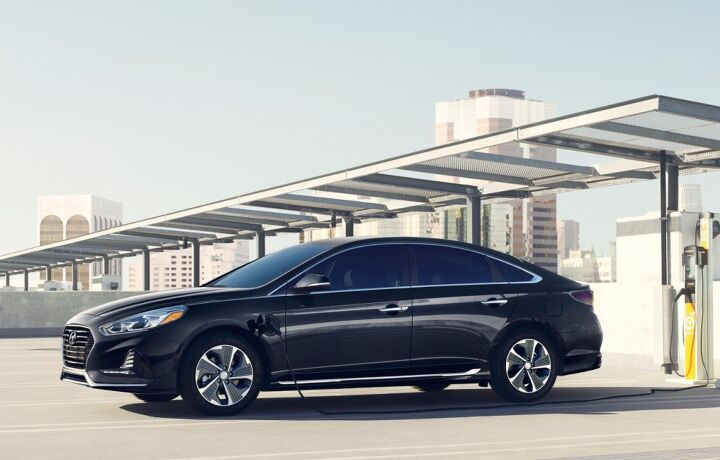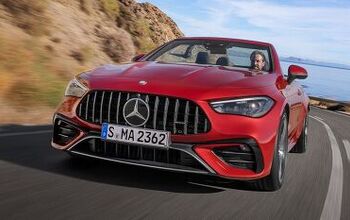Plug-in or Not, Hyundai Doesn't Want to Be Seen as the Expensive Choice

Exclusivity is not a word often associated with Hyundai, and with good reason. Like Nissan (but even more so), Hyundai’s reputation is built on a foundation of mass-produced vehicles with inherent value. And, even in the world of green cars, it seems that game plan can’t change.
So, it’s no surprise to see Hyundai take a hatchet to the price of its 2018 Sonata Plug-in Hybrid. In dropping the model’s entry price by $1,350 and adding one mile of electric driving range, Hyundai hopes it’s enough to attract the attention of would-be buyers. It needs to. In June, the model sat at 21st place on the public’s PHEV shopping list.
Starting now, a Sonata PHEV will set you back $33,350 before a $885 destination charge, while the Limited model grows $250 to $38,850 before destination.
For the base sticker, you’ll see the same 2.0-liter inline four and 50 kWh electric motor, the latter of which is good for 67 horsepower. The transmission remains a six-speed automatic. Hyundai now claims an EV driving range of 28 miles, up from the 27 advertised when the 2018 model debuted at the Chicago Auto Show. Any improvement is a good one, we suppose.
While cutting the entry price obviously adds value to the base model, the Limited’s slight price hike brings many new features aboard — LED headlights with “Dynamic Bending Light,” automatic emergency braking with pedestrian detection, a heated steering wheel, Driver Attention Alert, a wireless charging pad, and a USB port for rear seat passengers.
In a market awash with plug-ins, how has the Sonata fared? Not well, compared to other low-priced PHEVs. Granted, the 2018 model launched well after its Hybrid sibling, meaning that buyers could only source the old-style previous-generation model (even as the stock gasoline-only Sonata’s new design became old hat).
In June, Hyundai sold just 62 Sonata Plug-in Hybrids, a year-over-year drop of 29.5 percent. Over the first half of 2018, the model’s volume shrank by 28.9 percent. Even the plug-in version of the Kia Optima sells better. Year to date, Ford sold more than ten times as many Fusion Energi sedans.
The base Fusion Energi SE, which carries a range of 21 electric miles, stickers for $31,400 before destination — nearly two grand less than the new, cheaper Sonata PHEV.
[Images: Hyundai]

More by Steph Willems
Latest Car Reviews
Read moreLatest Product Reviews
Read moreRecent Comments
- VoGhost Just reminding us all that we have to tolerate dealers (many of whom are billionaires) in the US if we want new legacy ICE vehicles because the dealers pay for the campaigns of local politicians, with our money.
- 1995 SC I'm still trying to get past the fact that the Red Bull guy is married to a Spice Girl.
- Ravenuer Not into F1. Started watching NASCAR back when they raced actual cars. (yeah I'm that old). Not any more. They aren't "stock cars" now. Not even close. Even drag races don't interest me anymore. Races are over in 3 seconds.
- Wjtinfwb No confusion on my end, Ghost. The Government has zero role in job creation outside of the legitimate opportunities' created by Government going about it's responsibilities, namely keeping the American people and territory safe from foreign intrusion. Of course, they're failing epically at that but that's a different topic. The American free enterprise system is what enables job creation. Government's role is to stay out of the way of that system, but they seem incapable of doing so. Oil & Gas exploration is just one example. If a National Job Policy is what you're looking for, there are other countries that will be happy to accept your application for residency.
- Michael Smith I drive 100-300 miles a day in new BMWs, Mercedes-Benzes, and GM SUVs. Some are already equipped with automatic braking.It's the first thing I turn off when I start the car.I've had experiences where (as the author notes) the system gave false alarms and stabbed the brake pedal, threatening my ability to control the car.Further, every driver encounters situations where, for example, legal following distance must be momentarily compromised in order to avoid a difficult situation. When the system intervenes, it disrupts the driver's plan of action. This can lead to a collision as the driver has to suddenly react not to his surroundings, but to the system.Not only is automatic braking an insult to skilled drivers, it's dangerous to everyone.



































Comments
Join the conversation
I would gladly pay more for more horsepower. I imagine a bigger motor + battery would cover that price drop, add range, and give these kinds of cars decent acceleration without affecting gas mileage. I want a hybrid for my next car, but it's gotta run a 14 second quarter mile and burn regular gas. I honestly don't think such a car exists.
Unless gas prices go up more (and stay) up, most drivers (not in high gas price areas) won't see a return on a PHEV. Even a regular hybrid system take years to see a return; however, a 48V mild hybrid system would benefit the typical daily driver.